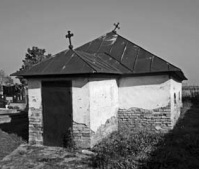Family Čarnojević became prominent and famous for the most prominent representative of Patriarch Arseny III. Members of one branch of the family (bearers of the noble predicate Černović de Mača), under the leadership of Pavel Čarnojević, moved to Rusko Selo in 1797. Until 1823, he lived in a low, dark, bullet-proof house that was covered with reeds, and looked much like homes of poor arrivals. In 1823 he built a castle, which had the appearance of semi-solid. He built it from hard material. In addition to the castle, the high walls were surrounded by auxiliary buildings in which servants and renters lived. To the south of the castle there was a vineyard, and across the street there was a park arranged in English. The park was closed by a solid, gable iron door. On their wings there were the letters P. Č. – initials of owner Pavle Carnojevic.The property of Pavel Carnojevic was 5500 kj. of which 1000 kj. fell off the forest. With rich rent, he supported the servants and hirelings and settled the enormous expenditures he and his son Peter made, creating a lavish life. Paul remained in the village until his death in 1840. He was buried by the bishop of Temišvar Pantelejmon Živković. He was imprisoned in the Matica of the deceased Romanian Orthodox Church: “Pavle Carnojević, died on May 29, 1840, buried on June 1, 1840.” On the basis of these data, it can be safely claimed that Pavle Carnojević retained his faith and nationality for the rest of his life. After Paul’s death, the entire estate was inherited by his son Peter, who was born on March 13, 1810 in Maca. Peter was an educated man who traveled a lot. He played a very important role in the political life of Hungary. He wore the Count’s title.At the Hungarian National Assembly in 1843 he was a deputy of the Arad County.
During the bun 1848/49. He was appointed as the Royal Commissioner for Southern Hungary by the revolutionary government. After the suppression of the rebellion in 1848 in the Kikinda districts and other parts of southern Hungary, the authorities engaged Petar Čarnojević in punishing the culprits. According to the Hungarian government’s decree of April 27, 1848, he organized the courts.
As far as the decree was concerned, the scope of Carnojevic’s powers was particularly broad. He did not have the time to participate in the work of the Kikinda Cross Court. He organized it and then left the place. Later he organized such courts, all over Backa and Banat. “Srpske novine” from that period in the following manner writes about him: “The suspicion she had of Serbs about Čarnojević has already completely come to the fore. He does not act in his first, bloodthirsty commission as a Serb, but as an angry Serb. He saw 900 Serbs in Kikinda, hanged two, and six wait for the same fate … Carnojević is neither a mind nor a heart Serb … and where he acts, he is not armed by an angel-peace-loving peace but legitimate soldiers and gentlemen. ”
In this position, he tried to sneeze between two completely antagonistic blocs: the rebellious Serbs and the Hungarian state authorities. He experienced complete failure, as the Serbs did not accept him as representatives of their interests, while the Hungarian government, shortly afterwards, ousted the function because of insufficient courage to counter the uprising.
After the revolution, he did much to develop theatrical art in Arad. From 1865, during the three hearings he represented the Arad County in the Hungarian Parliament. It was noted that in 1861 he was a deputy at the Karlovac Memorial Assembly. He appeared in the most earnest on him, but he did not participate in the work of the Parliament and in the political life of the Serbs. He is known to have been writing. In 1861, he published a work entitled “A National Question from the View of the Present and the Future” in Pest. He died on April 27, 1892, in Fenj. The remains were transferred to the Russian village and placed in a family tomb. The church rite was performed by a priest of the Romanian Orthodox Church. The deceased members of the family Carnojević, in the period 1840-1911. They were buried in a grave that was erected in 1843, at a village cemetery behind the church.
The tomb was built of brick, plastered and painted. The base is rectangular. It is decorated with a semi-spherical vault, above which is a four-roofed roof. The entrance part is pushed out from the west side, rectangular base and three-sided sheet metal. The door is iron, and on the sides there are five semicircular windows with solid wrought iron gratings. There are thirteen wooden and metal crates in the grave. The tomb was robbed after the First and Second World War.
Little did she care for her until 1936, when the Ministry of Agriculture bought it from the Countess Sečenji and with the rest of the property that belonged to the family, they were handed over to the Church Municipality. In the same year, the Church Municipality requested assistance in the amount of 20,000 dinars from the Ban of the Danube Banovina. The appeal of October 28th was resolved positively, and the tombs from the obtained funds were generally corrected. The original roof cover from the shingle was replaced by a galvanized sheet.
TOMB OF THE ČARNOJEVIĆ FAMILY


0 comments on “TOMB OF THE ČARNOJEVIĆ FAMILY”